This simple DIY shea butter lotion recipe (made with just 3 ingredients) is the perfect moisturizer for the whole body, face included, and may be used for acne-prone and aging skin.

Want to Save This Article?
Enter your email & I’ll send it straight to your inbox. And you’ll get new recipes & tips each week.
I’ll guide you, step-by-step, through how to make shea butter lotion, using shea butter and no coconut oil (because coconut oil can and will clog pores). The final product is a non-greasy, 100% natural moisturizer, with a creamy consistency and skin-soothing properties.
This recipe is used just like store-bought body lotions: to moisturize the face, hands, feet, legs, arms. Technically, this is more of a homemade body butter recipe: a thick moisturizing cream versus a pumpable lotion. (Make pumpable lotion recipe here.)
But whatever you call it, it’s one thing: AMAZING!
What is Shea Butter?
Shea butter comes from the “nut” (or pit) of the fruit found on the Karite Tree. It is soft, compared to cocoa butter, and has a strong scent when it’s purchased in an unrefined state.
I use unrefined shea butter in body-care recipes, but if you don’t care for the (natural) fragrance, I recommend using refined shea butter. Shea butter softens and moisturizes the skin, making it perfect for homemade lotion, shaving cream, and lip balm.
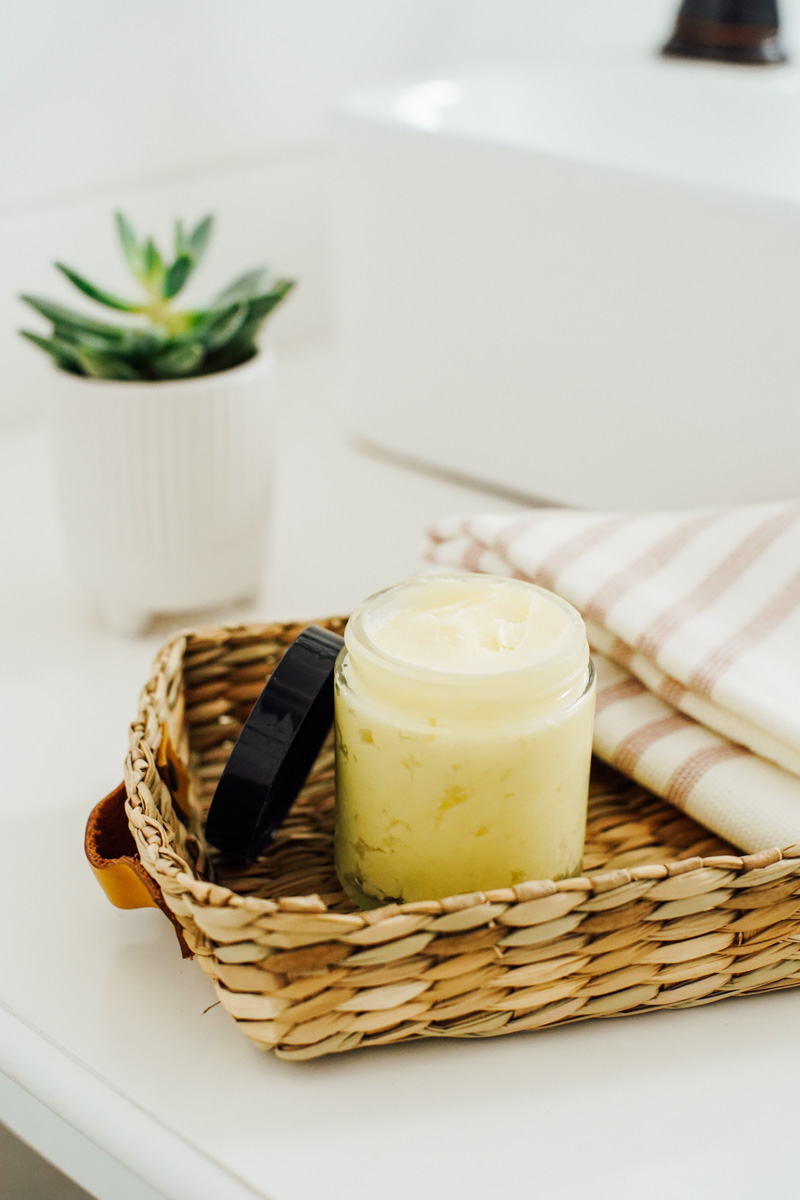
Benefits of Shea Butter
Shea butter is the main ingredient used to make homemade body lotion and many other skin care products.
- It’s naturally rich in vitamins and fatty acids, like vitamin A and vitamin E.
- It contains anti-inflammatory, antibacterial, and antioxidant properties. It’s ideal for sensitive skin and as an anti-aging product. There’s even evidence that shea butter could help with wrinkles.
- Shea butter helps to combat dry skin. It’s an emollient: traps moisture on the skin without clogging pores. There’s also some evidence to suggest that it may help to alleviate eczema symptoms and soften scar tissue. Source: Medical News Today
- Shea butter contains stearic acid, a naturally occurring fatty acid, that allows the butter to spread smoothly on skin without tension. This makes it ideal for a body and face moisturizer since it will melt right into the skin!
I personally use shea butter moisturizer every night before bed. And I’ve seen the texture and softness of my skin improve.
Before You Get Started: Ingredients & Tools
The natural ingredients can be found at most health food stores or online via Amazon. Each ingredient is carefully chosen for its natural moisturizing properties.
Video Recipe Tutorial
How to Make Shea Butter Lotion: Step-By-Step Instructions
Here’s the best way to make shea butter lotion, step by step.

Step 1: Melt Shea Butter
Heat the shea butter to melt it, don’t burn it. To avoid burning the shea butter, create a DIY double boiler. This will allow you to melt the shea butter without it directly touching the heat.
Place a medium-size glass bowl over a sauce pan filled 1/4 the way full with water. The glass bowl should sit just on top of the saucepan, without touching the water in the pan.
Over medium heat, allow the water in the saucepan to simmer. Then add the shea butter and melt.
Once the shea butter has fully melted (about 2-3 minutes), turn off the heat and remove the bowl from the heat.
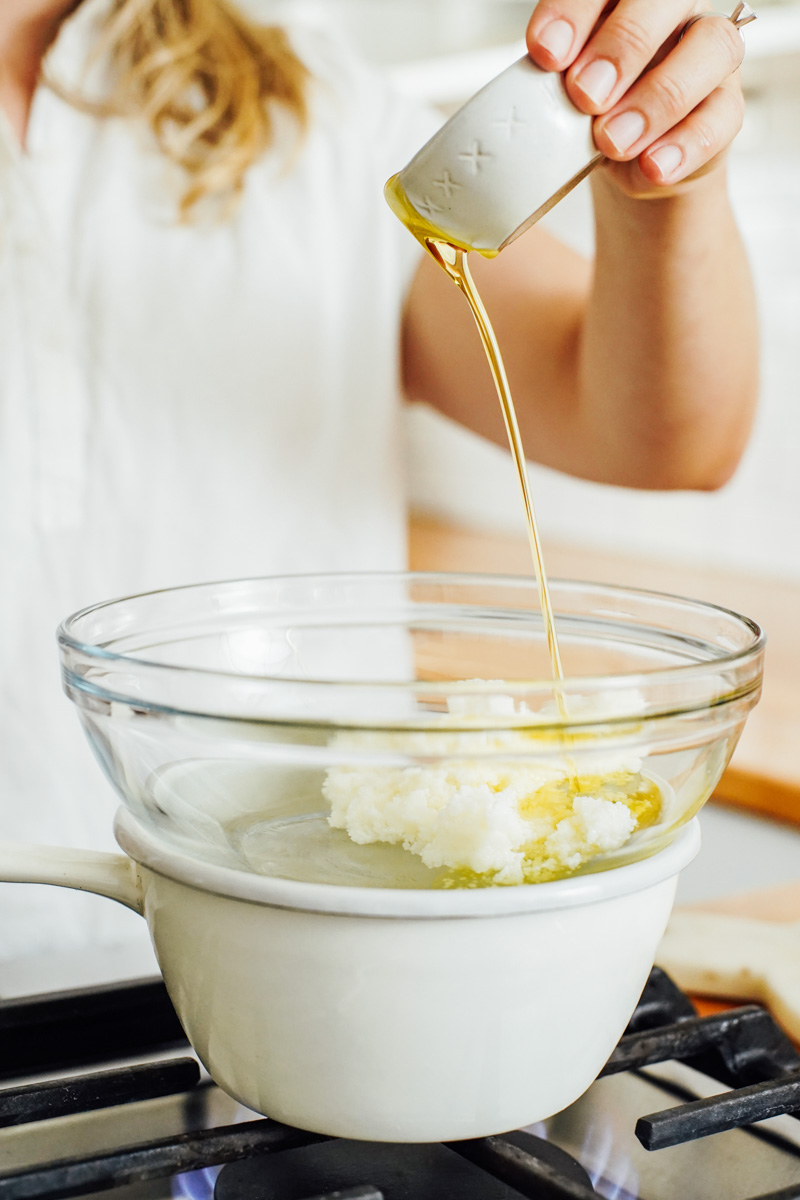
Step 2: Add Nourishing Carrier Oil
Stir 1 teaspoon of arrowroot starch into the liquid oil of choice (grapeseed oil, sweet almond oil, OR jojoba oil) and whisk to combine. Pour the oil (and arrowroot starch whisked in, if using) into the shea butter.
You can skip the arrowroot starch and add the oil directly to the shea butter at this step. The arrowroot creates a non-greasy lotion.
How do you make non-greasy shea butter lotion? Adding arrowroot starch, which is similar to cornstarch, is the best option. You’ll find this ingredient in the baking section at most grocery stores or online. This ingredient may also be used in cooking: make almond flour cookies and waffles or thicken stir-fry sauce.
Step 3: Cool in the Fridge
At this point, the shea butter and oil mixture should be cooler (along with the bowl).
If not, allow it to rest for a few minutes. Then place the mixture in the fridge and allow it to solidify (about 30 minutes to 1 hour, depending on location in the fridge and temperature).
Alternatively, speed up the process by placing the bowl in the freezer.

Step 4: Add Essential Oils
Once the mixture is opaque and firm (not solid as a rock), remove the bowl from the fridge.
Add the essential oil (or a combination of essential oils) of choice, if desired. Add up to 15 drops of skin-safe essential oils to this mixture. A few of my favorite essential oils to add are listed in the recipe below.
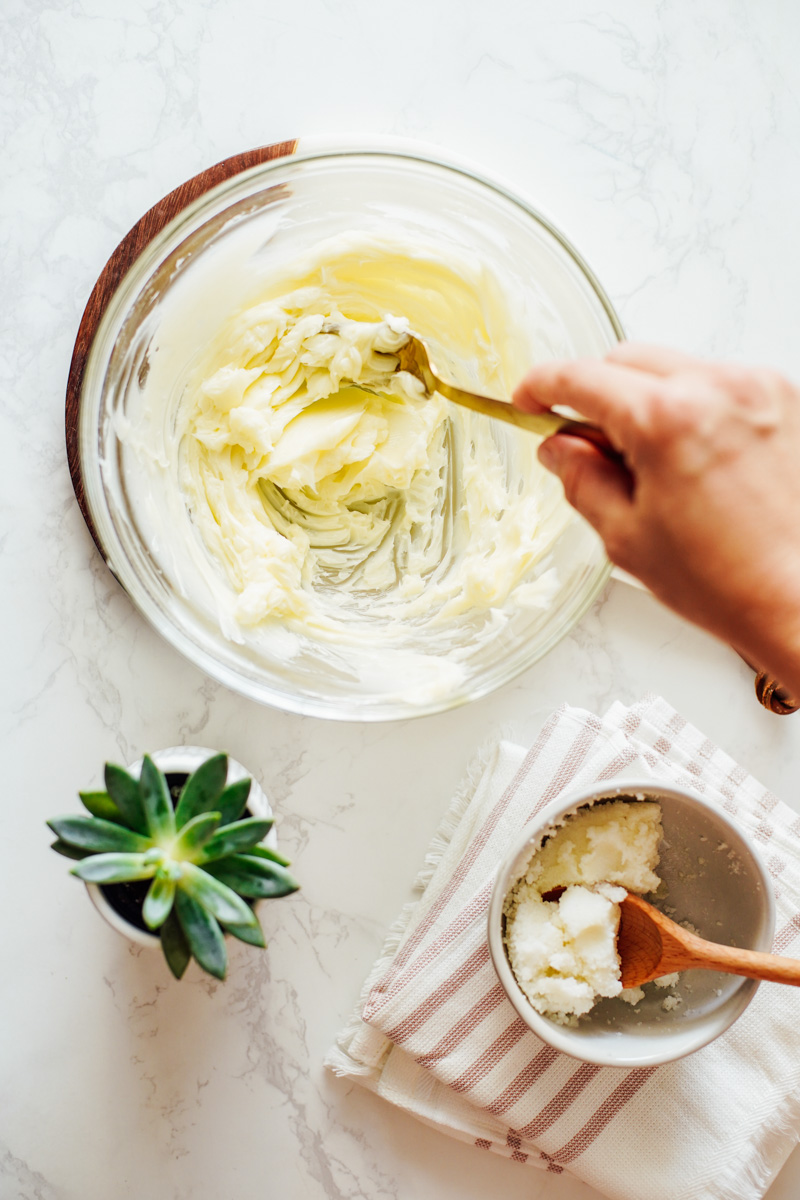
Step 5: Whip the Shea Butter
Use the whisk attachment and an electric mixer, hand mixer, or a fork to whisk the mixture until it appears “whipped.” This doesn’t take very long, just a few seconds using a mixer and a bit longer with a fork.
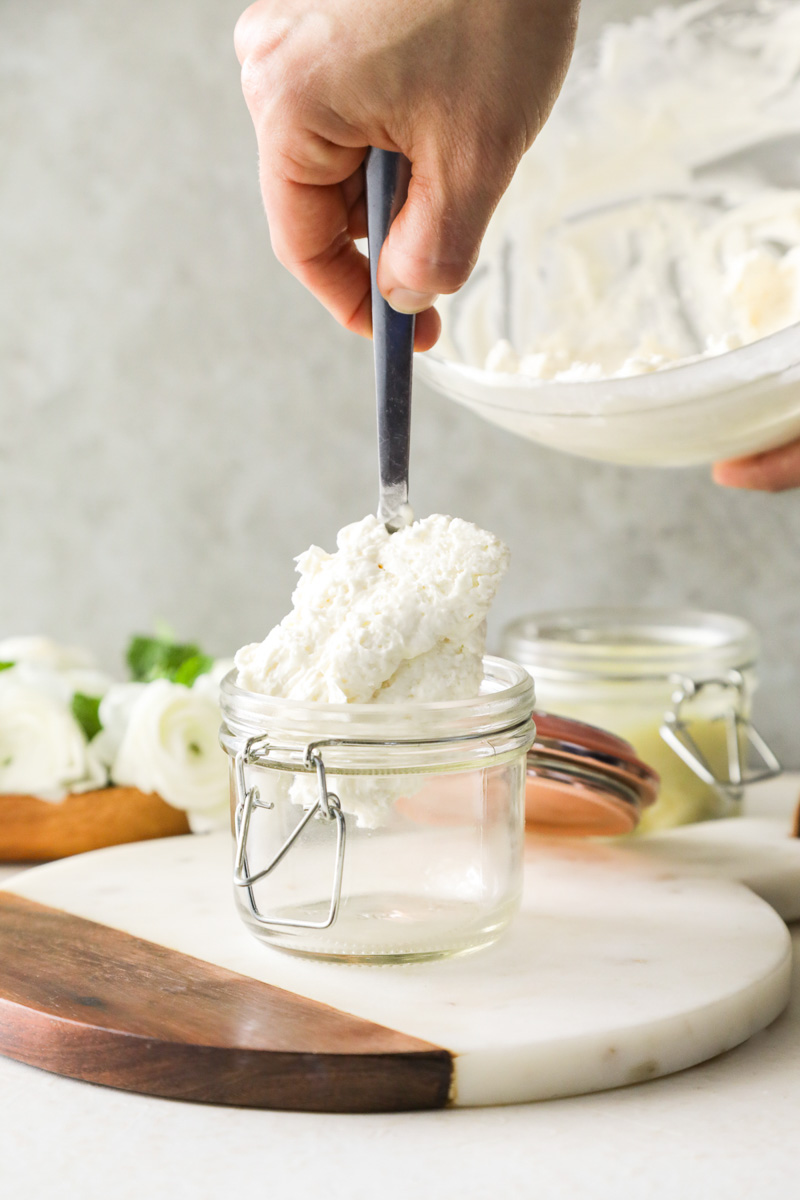
Step 6: Spoon Lotion into a Jar
Now you get to enjoy this amazing homemade lotion recipe and all its benefits (we’ll talk about the awesome benefits in a minute). Or, share the lotion as a gift.
Choose a beautiful glass jar and spoon your creation into the jar. Add a label, if desired. And store the lotion at room temperature in a cool place (like a bathroom cabinet) for up to 6 months.
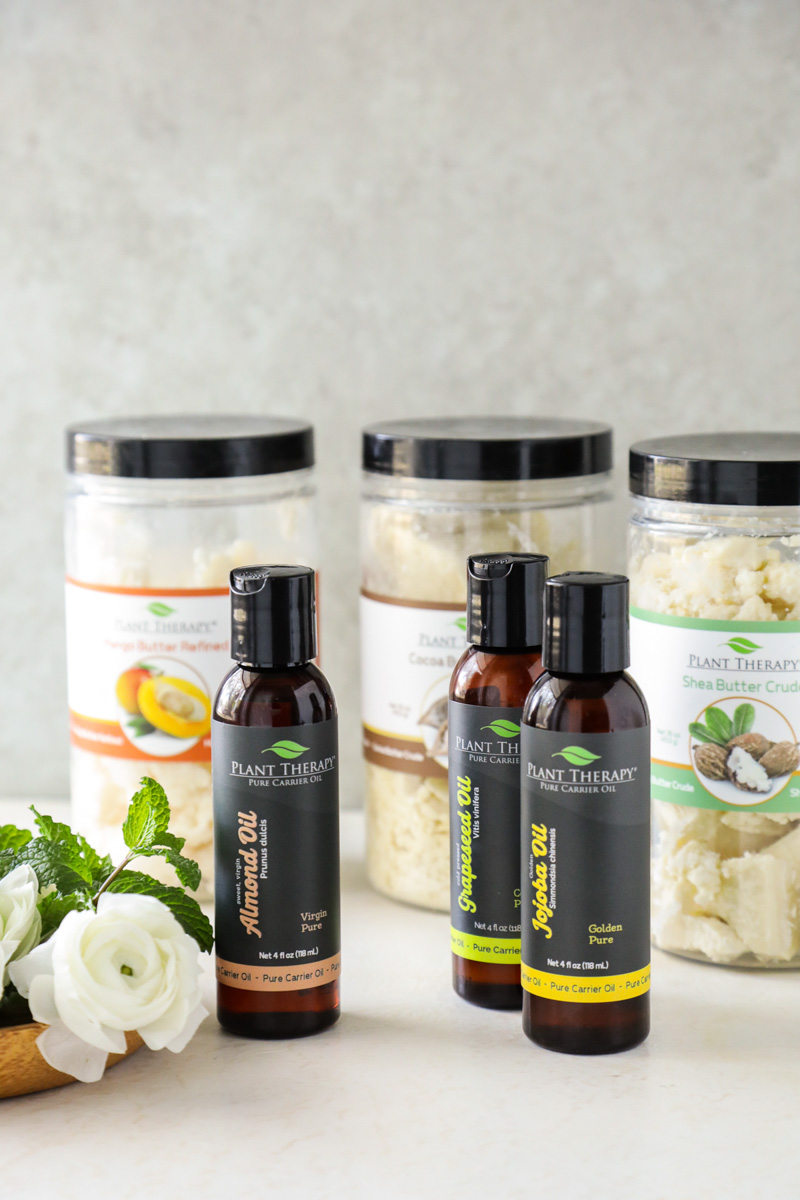
How to Choose a Carrier Oil
You can use shea butter alone as a body and face moisturizer, or you can mix it with a carrier oil to make a whipped body butter recipe or lotion (like this recipe).
Here’s what I recommend for a nourishing carrier oil to mix with the shea butter. The options absorb easily in the skin, making them the best options for a non-greasy lotion.
Jojoba Oil: Jojoba oil is made from a shrub that grows in Northern Mexico and the Southeast US. Jojoba is an emollient: a natural moisturizer that softens and moisturizes skin. Jojoba is the closest to our skin’s natural oil, making it ideal for all skin types.
Grapeseed Oil: This oil comes from pressed grape seeds. It has high amounts of fatty acids, vitamin E, and antibacterial properties. Grapeseed oil may be a great option for aging skin and for those with acne-prone skin.
Sweet Almond Oil: Made from sweet almonds and rich in vitamin A & E, fatty acids, and proteins.
Virgin Coconut oil is also an option, but as I’ll share in a minute, I don’t care for using coconut oil on my face. If you’re just using this lotion on your body, coconut oil may be a good option.
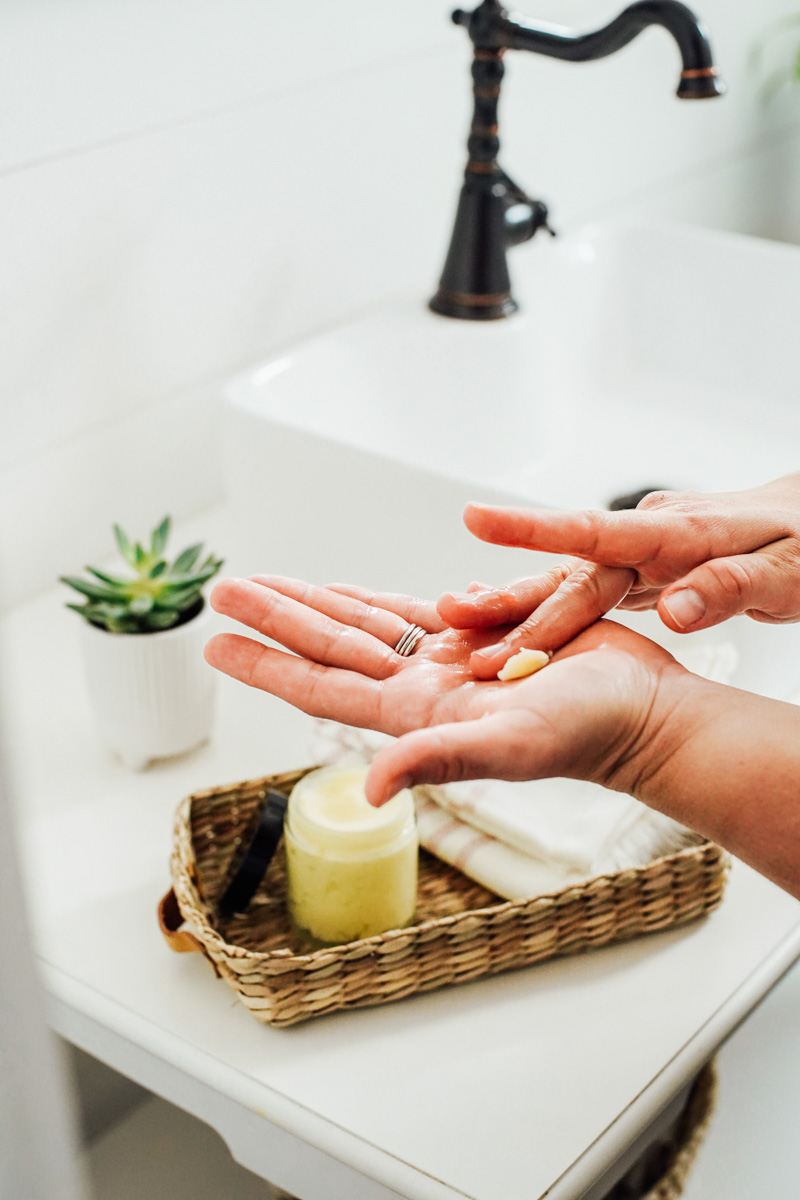
How to Use
Scoop a small amount of shea butter lotion out of the jar using your finger, then rub between your hands. The heat from your hands will soften the shea butter. Massage into your skin: face, arms, legs, feet, dry patches, etc.
A little goes a long way.
For the face, apply this moisturizer after cleansing (my favorite natural face cleansers) and toning (a spritz of rose water is my favorite). If you use any serums, apply a facial serum before applying the lotion.
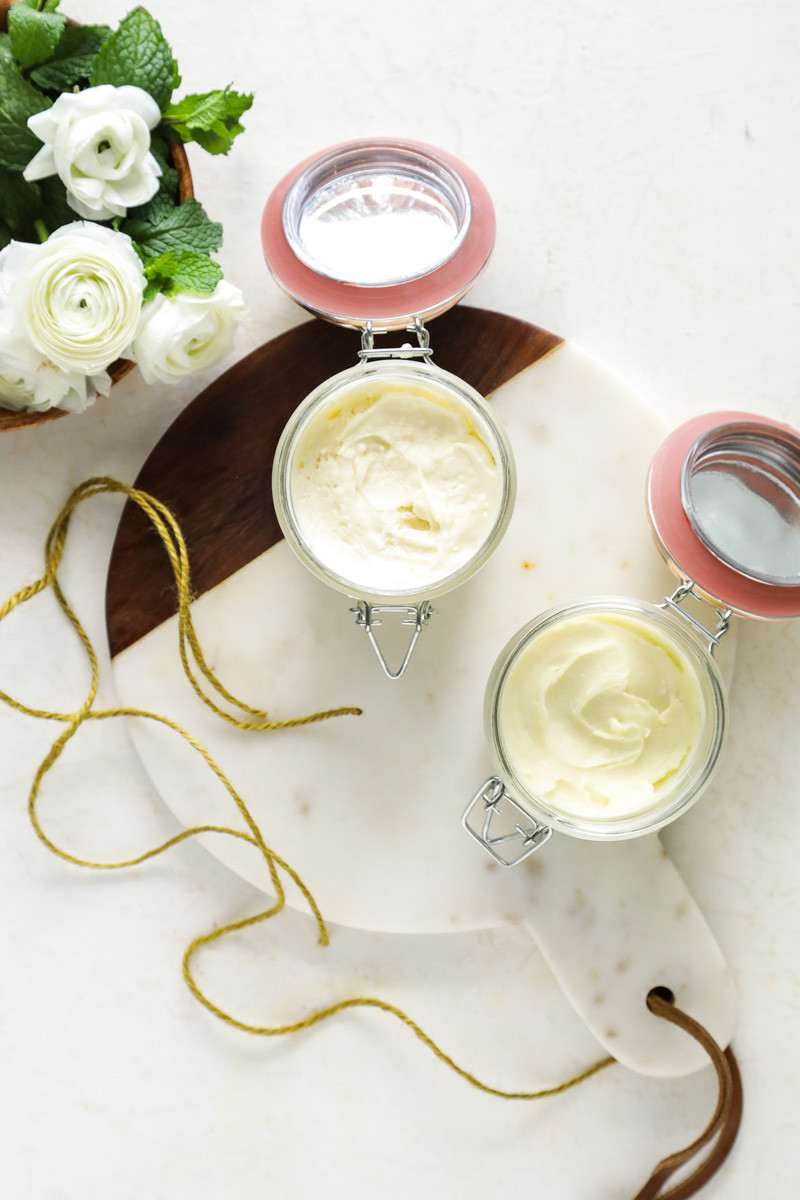
What’s the Shelf Life?
This natural lotion recipe doesn’t use any preservatives. Store-bought lotions add preservatives to formulas out of necessity. Without a preservative, mold and other bacteria will grow in a water-based lotion.
This recipe doesn’t need a preservative because it doesn’t use water in the formula. This means you can make a long lasting moisturizing lotion, without using any preservatives and don’t need to worry about mold growth. Woohoo!
Store the final product at room temperature, in a cool dry place, for up to 6 months. I recommend keeping homemade shea butter lotion away from heat, like a hot steamy shower, since it will melt slightly. This recipe is intended for home use; not to be sold commercially.
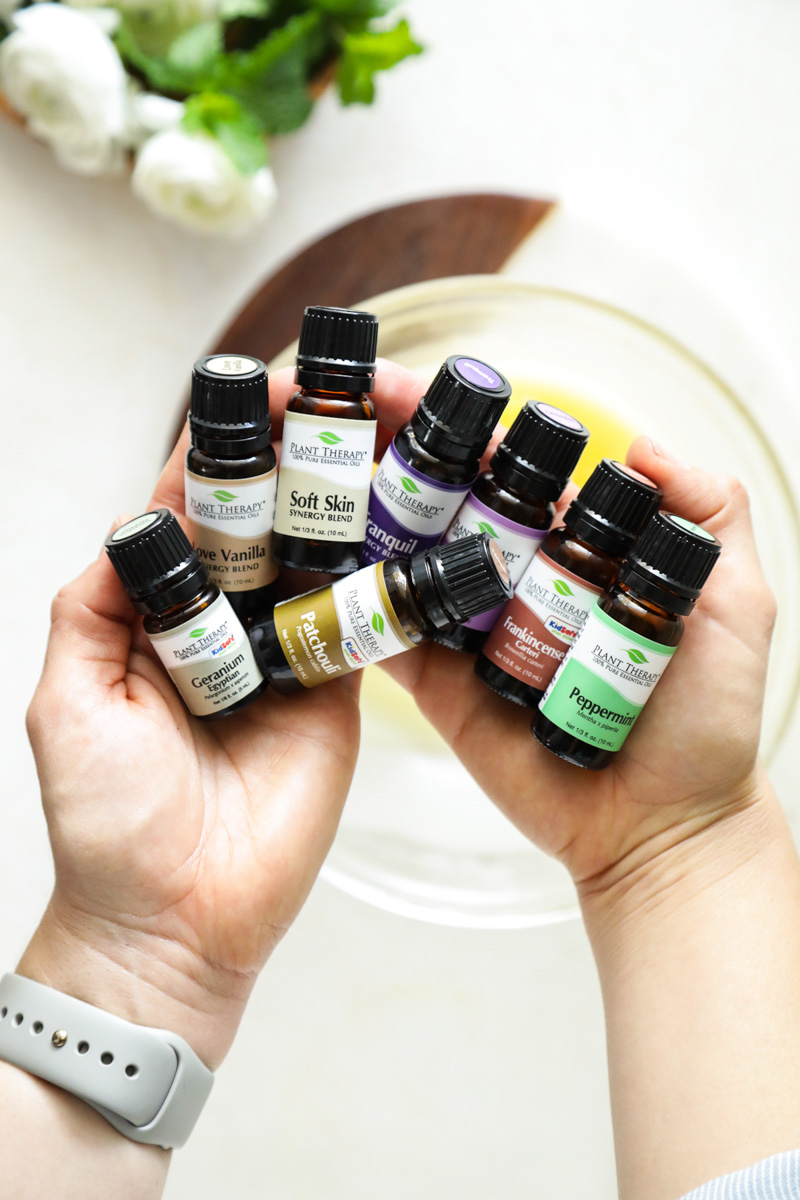
How to Add Essential Oils
If you want to scent your own lotion, essential oils are the best way to do this! Along with their scent, essential oils are easily absorbed by the skin for nourishment, and provide antibacterial and soothing properties.
Add one essential oil or a combination of essential oils, totally 15 drops, to this lotion recipe. The best essential oils for homemade lotion are…
- Roman Chamomile
- Frankincense
- Lavender
- Rosemary
- Jasmine
- Carrot Seed
- Rose
- Lavender
- Tea tree
- Sandalwood
- Geranium
Essential Oils to Avoid: Avoid citrus essential oils (like lemon or orange essential oil) if you plan to wear this lotion during the day when exposed to the sun. Citrus essential oils are photosensitive and can cause your skin to develop a rash or sunburn.
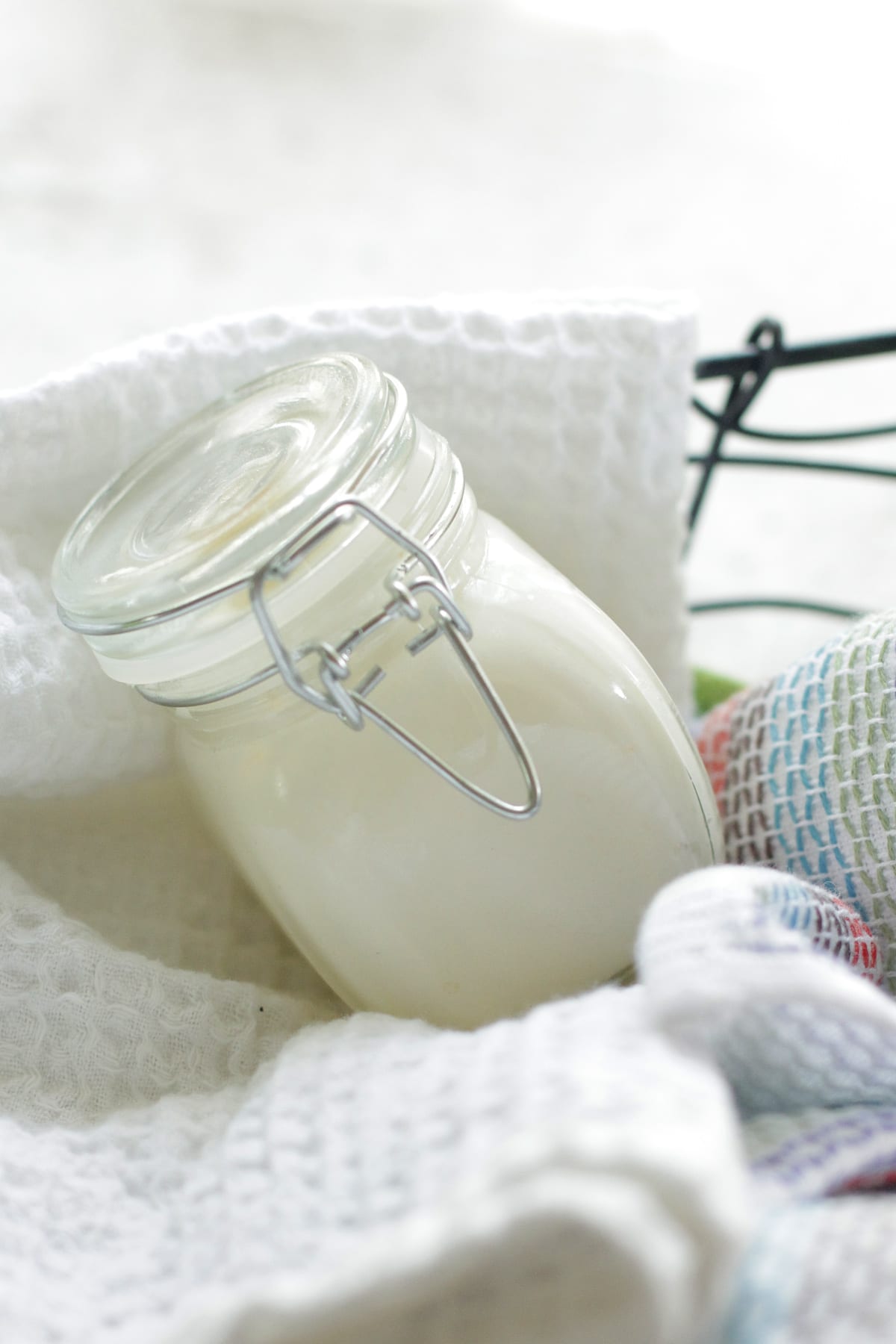
Lotion Without Coconut Oil, Here’s Why
You’ll notice that this recipe doesn’t use any coconut oil. A lot of lotion and homemade whipped body butter recipes rely heavily on coconut oil.
Coconut oil is not the cure-all. Gasp, I know. That statement is practically heresy in the natural living community. Toothpaste? Coconut oil. Smoothies? Yep, coconut oil. A boo-boo? More coconut oil. We use it for everything! I’ve learned the magical oil isn’t always suitable for every need.
Many years ago, I decided it was time to ditch the toxins found in our bathroom. From lotions to body wash to makeup, the amounts of toxins I put on my body was astounding. With the urge for simplicity and natural living, I started developing my own replacements for things like foundation powder and lotion.
One of my very first DIYs was a simple homemade moisturizer using coconut oil. After a few weeks of using this moisturizer on my face, I experienced multiple break outs, daily peeling, and dry skin patches. Here’s why…
There’s nothing wrong with coconut oil, but from a skin care perspective, it’s not the best moisturizer option for the face. If you use it on your face, it’s likely to clog pores and cause breakouts due to its chemical composition.
Shea butter does not clog pores and is the best moisturizer option. So skip the coconut oil on your face and instead turn to shea butter and a non-clogging carrier oil!

FAQs
6 More Ways to Use Shea Butter
- Use shea butter to make homemade deodorant. You’ll also need arrowroot starch for homemade deodorant.
- Combine shea butter, coconut oil, and castile soap to make homemade moisturizing shaving cream.
- Combine butter, carrier oil, and beeswax to make Shea Butter Lip Balm or a custom DIY Lip Balm.
- Jojoba oil, coconut oil, shea butter, and soothing herbs come together to create DIY lotion bars.
- Shea butter, aloe vera, chamomile, and coconut oil make a fantastic homemade diaper rash cream.
- Use shea butter combined with mango butter and cocoa butter to make a customized body butter.

Homemade Moisturizing Shea Butter Lotion Recipe (Without Coconut Oil)
Equipment
- 1 electric mixer or fork
- 1 medium-size heat safe bowl
- 1 medium-size sauce pan
- 1 4-ounce glass storage jar (or larger)
Ingredients
- 1/2 cup shea butter (4 ounces)
- 1 teaspoon arrowroot flour starch (optional, to make a non-greasy lotion)
- 2 tablespoons nourishing carrier oil such as: jojoba, sweet almond oil, or grapeseed oil. This can even be coconut oil or olive oil (if not using on the face).
- 5 drops lavender essential oil optional*
- 5 drops rosemary essential oil optional*
- 3 drops carrot seed essential oil optional*
- 2 drops tea tree essential oil optional*
Instructions
Step 1: Melt Shea Butter
- To melt the shea butter, make a DIY double boiler. This will allow you to melt the shea butter without it directly touching the heat.
- Place a medium-size glass bowl over a sauce pan filled 1/4 the way full with water. The glass bowl should sit just on top of the saucepan, without touching the water in the pan.
- Over medium heat, allow the water in the saucepan to simmer. Then add the shea butter and melt.
- Once the shea butter has fully melted (about 2-3 minutes), turn off the heat and remove the bowl from the heat.
Step 2: Add Nourishing Carrier Oil
- Stir 1 teaspoon of arrowroot starch into the liquid oil of choice (grapeseed oil, sweet almond oil, OR jojoba oil) and whisk to combine. Pour the oil (and arrowroot starch whisked in, if using) into the shea butter.
- NOTE: You can skip the arrowroot starch and add the oil directly to the shea butter at this step. The arrowroot creates a non-greasy lotion.
Step 3: Cool
- At this point, the shea butter and oil mixture should be cooler (along with the bowl). If not, allow it to rest for a few minutes.
- Place the mixture in the fridge and allow it to solidify (about 30 minutes to 1 hour, depending on location in the fridge and temperature). Alternatively, speed up the process by placing the bowl in the freezer.
Step 4: Add Essential Oils
- Once the mixture is opaque and firm (not solid as a rock), remove the bowl from the fridge.
- Add the essential oil (or a combination of essential oils) of choice, if desired. Add up to 15 drops of skin-safe essential oils to this mixture. A few of my favorite essential oils to add are listed in the recipe above. You can add your favorite essential oil or oils, not the ones listed above (if desired).
Step 5: Whip
- Use the whisk attachment and an electric mixer, hand mixer, or a fork to whisk the mixture until it appears "whipped." This doesn't take very long, just a few seconds using a mixer and a bit longer with a fork.
Step 6: Store
- Choose a beautiful glass jar (4 ounces or larger) and spoon your creation into the jar. Add a label, if desired. And store the lotion at room temperature in a cool place (like a bathroom cabinet) for up to 6 months.
Video
Notes
- Roman Chamomile
- Frankincense
- Lavender
- Rosemary
- Jasmine
- Carrot Seed
- Rose
- Lavender
- Tea tree
- Sandalwood
- Geranium
Natural Body-Care Simplified
Learn how to make your own body and beauty products with simple ingredients.

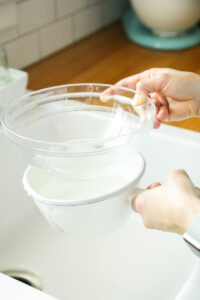
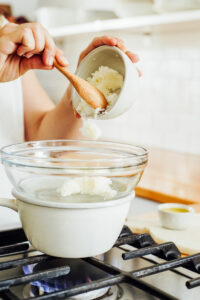
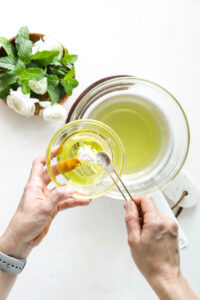

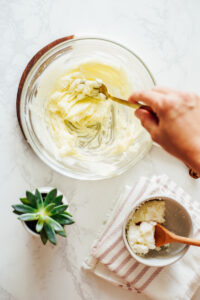
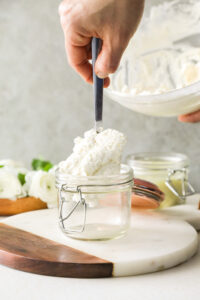
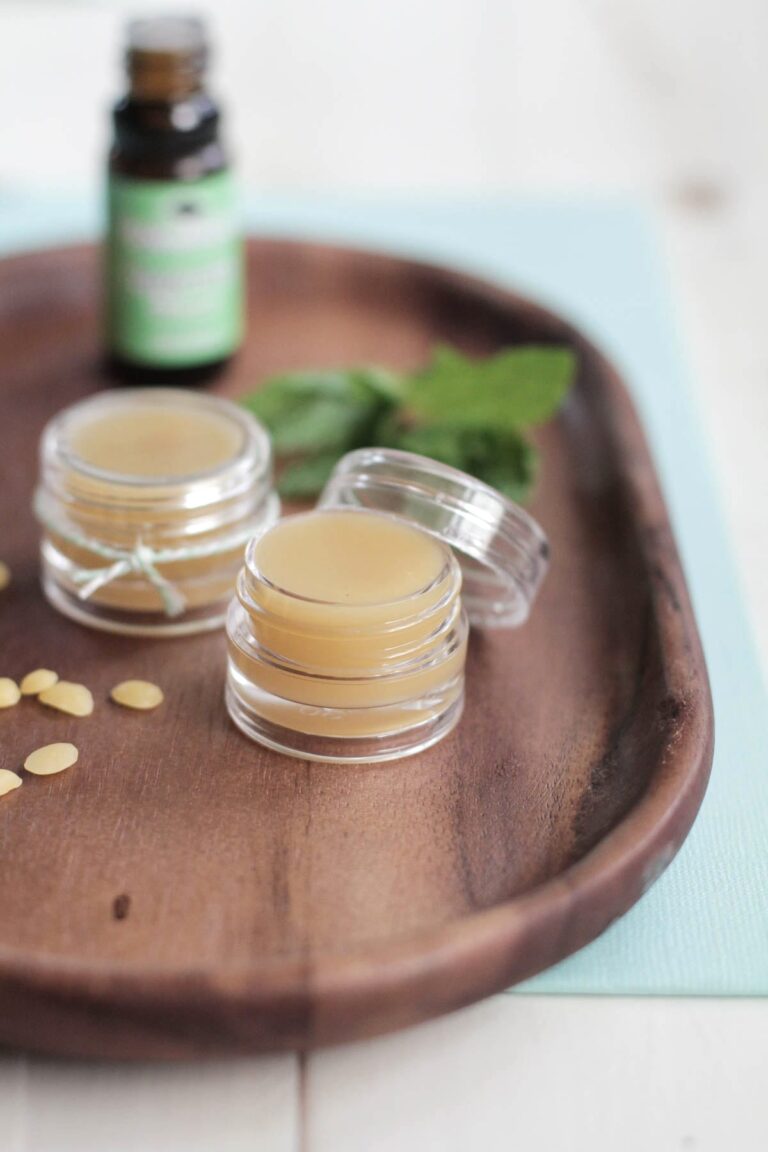
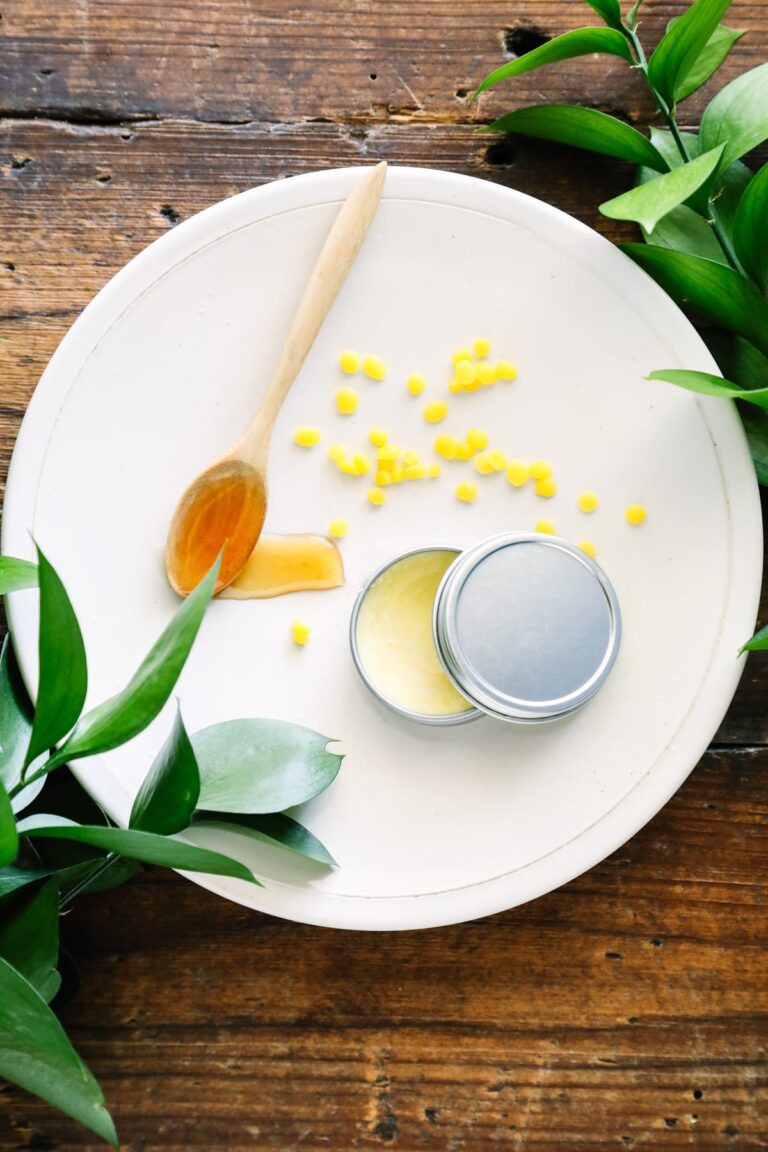
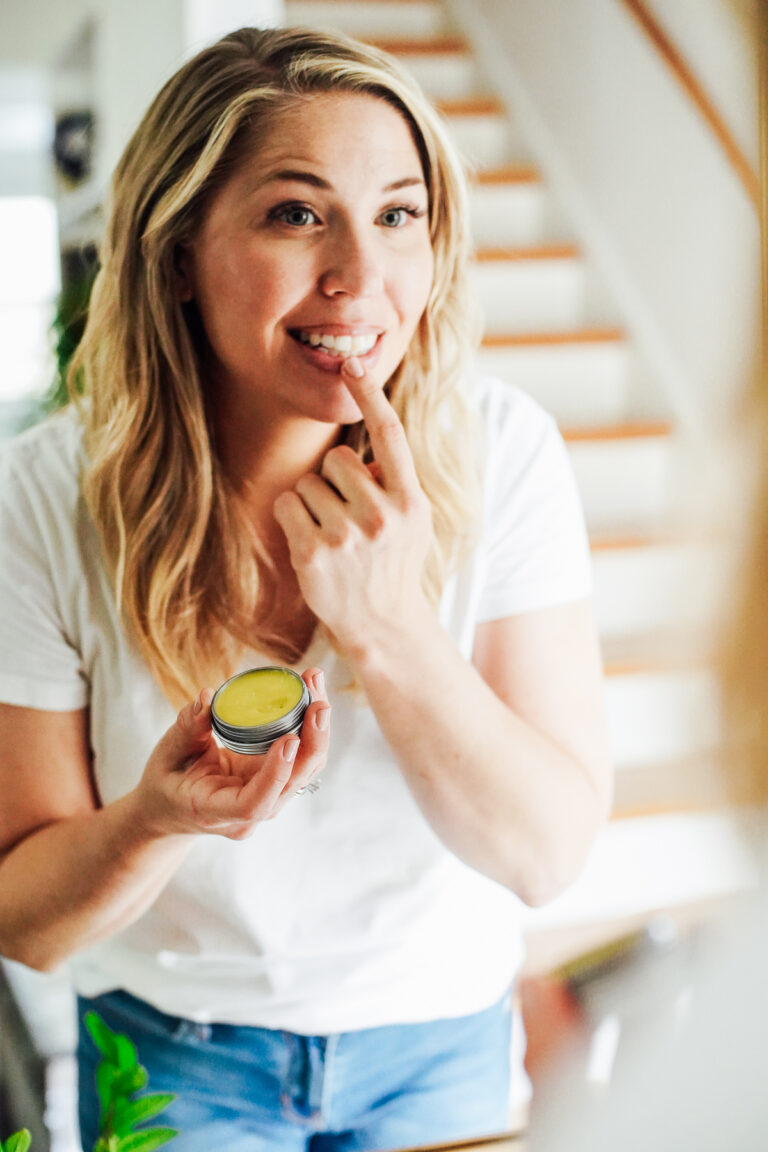
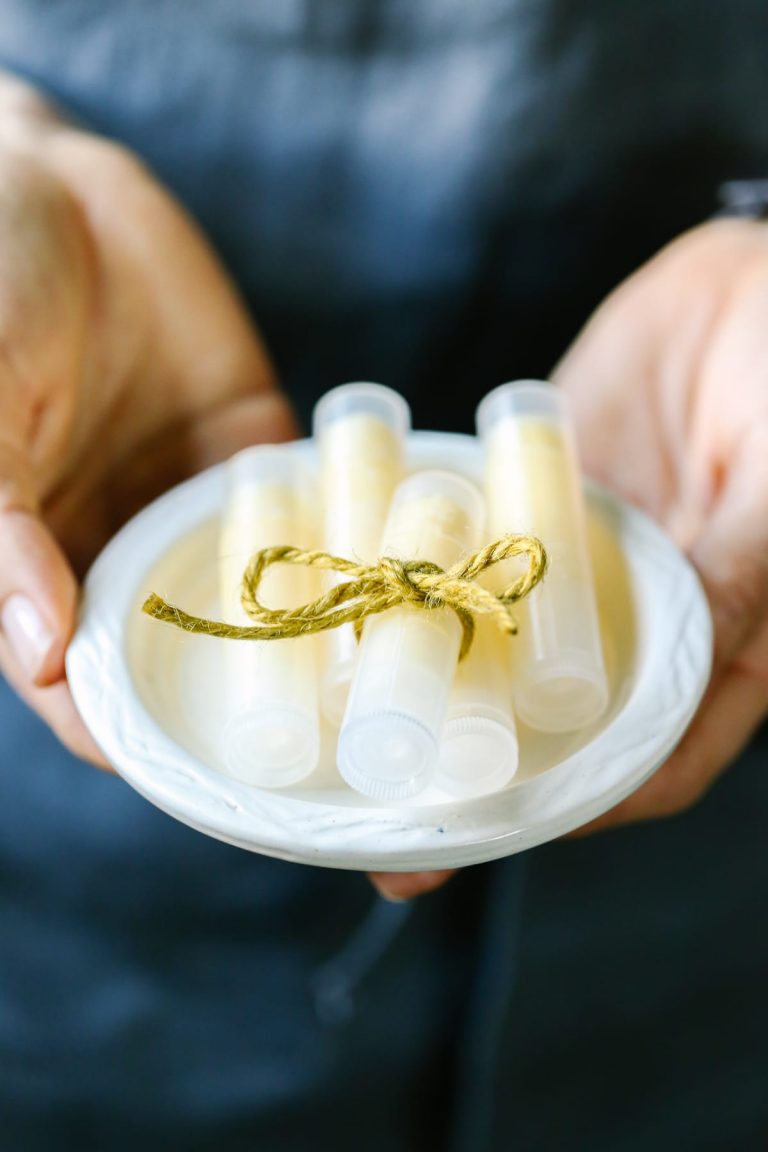
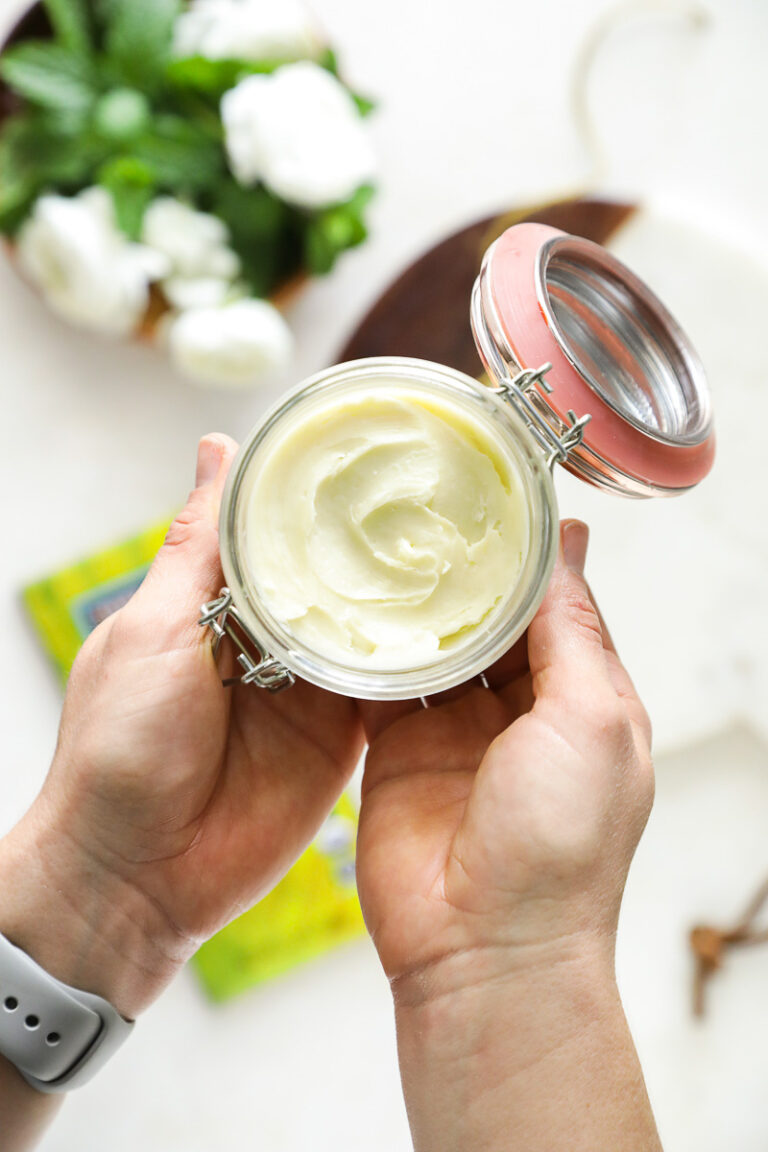
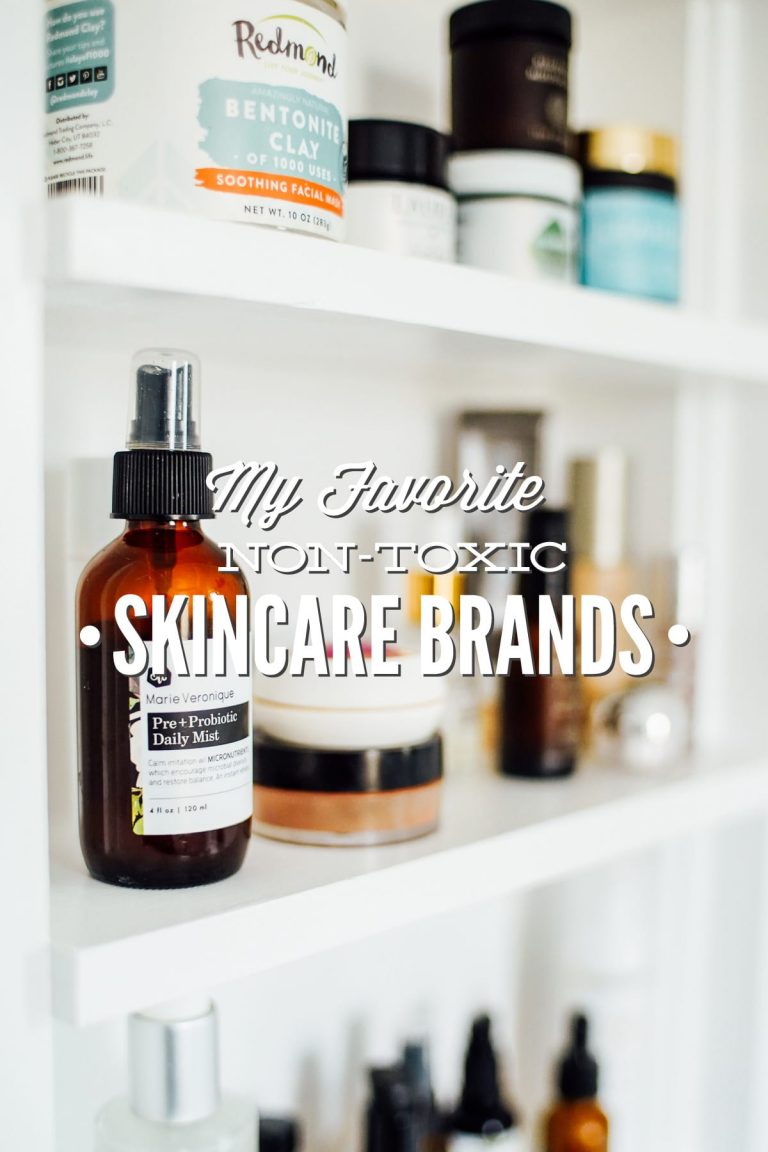
I made this and it’s absolutely solid. If I melt down and add more oil what will this do to the essential oils? Should I add more? Is there anything else I can add to it to make it less oily?
Hey Lesley, Did you add arrowroot starch to help decrease the oiliness? You can add more oil, but that may make it more oily – what kind of oil did you use? Adding more oil won’t effect the essential oils.
I followed the recipie and it’s extremely oilly. I used jojoba oil.
Do you think I could repeat it and add more arrowroot powder?
Hey Misty, Yes, you can do that.
I followed the recipe and ended up with a hard butter that was difficult to spread! I melted it again and made the following adjustments, and now it spreads much better (still wouldn’t call it a lotion) without feeling too greasy!
+ 2 tbsp carrier oil (I used almond oil)
+ 2 tsp arrowroot starch
+ 1/6 cup coconut oil
Awesome, Nayla. Thanks for sharing your experience.
Hi Kristin I love your site being permanently bedbound at a young age I love all sorts of crafts especially anything to do with essential oils I’ve managed to workout how to do it in bed I’m wanting to make this recipe as a Anti-Aging facial cream for mommy with the use of some really useful oils and your non greasy recipe but I’ve only got a 100g pot would you be able to work out the recipe for roughly that amount I’m not that good with maths probably because Im being home schooled don’t know why I’m on end of life care anyways so I won’t finish schooling I have something broken with my brain had 16 surgeries. If you could help it would be great. Thank you very much for your time and help. Take care. Rachy x
Hi Kristin,
I tried and tried and tried and, to no avail, have failed to produce a lotion that remains soft. While I only have a fork and an electric whisk to use for the whipping step, according to your recipe, a fork should work.
The first time I put the melted mixture in the freezer to cool and used a fork to whip it. It never became white (like in your video) but seemed soft enough. Within a few hours, it was hard again and impossible to use.
I melted the mixture again and then used an electric whisk. That had the same result; except that, while whisking it, I got loads of it all over the walls.
The third time, after melting the mixture again, I tried my food processor since it can make whip cream. I think I got closer to the desired result but no cigar. That being said, I’m wondering if the result would be better if I double the portions of your recipe.
One thing I noticed is that my mixture never had the same consistency as yours after cooling (whether it was cooled in the fridge or the freezer). In your video, when you’re putting it in your bowl after it’s cooled, while it’s a solid, it’s a soft texture.
I use a different recipe to make a body butter. With that recipe, while it’s liquid and before it goes in the fridge, I shake it vigorously for about a minute.
Without whipping it, that one remains soft enough to scoop out of the jar and spread easily as it quickly melts.
I’m wondering if I should add the shaking step to your recipe.
FYI…
I did not use the arrowroot as my skin is very dry.
Aside from purchasing an electric mixer, what would you suggest?
Hey Claude, This recipe isn’t going to be a super soft, airy, and whipped body butter as it doesn’t use coconut oil which is what most recipes with those results use. It sounds like you’re doing everything right to achieve the outcome of this recipe. You can double the recipe if it’s easier to work with more volume.
Loved all the information that went along with this recipe! Thank you!
Hi, I made this recipe, and I used a kitchen scale. I followed your instructions my best and while my result does look just like yours, it is not non-greasy for me. When applied and rubbed in, my hands look like I rubbed straight oil all over them and are oily/shiny. Do you have any idea why this is and how I might fix it? I really want this to work 😕
Hey Shannon, Did you add arrowroot starch? That will help a ton. Also, what oil did you use? The oil used can make a difference. Other than that, using a small amount and giving the lotion time to absorb in the skin will help.
Will corn starch work instead of arrowroot starch?
Hey Kitt, Yes, it will.
Hi Kristen! I tried making this lotion this weekend, but I had substituted cornstarch for the arrowroot powder, and used extra virgin cold pressed olive oil (as I had both of these on hand) and mixed into unrefined African Shea butter. I didn’t add any essential oils. I may have over-whipped, because it ended up being a little hard, but the main problem was it was a bit too heavy/greasy for my face at first, but did eventually absorb. From your experience, would you think I should add more or less of a certain ingredient in order to have it more of a whipped, lighter, non-greasy cream? Thank you so much!
Hey Olivia, You won’t really get a whipped, soft butter without using more oil. You could try adding something like a jojoba or almond oil, which are a bit lighter than olive oil and may help to reduce the hardness. Just melt the mixture in a double boiler, then add a bit more oil.
Can I use calendula oil instead of jojoba& the other oils. Because now I have calendula oil.
Hey Melek, I believe so.
Can you substitute corn starch for arrowroot starch?
Hey Karin, Yes, you can try it.
Hi, Kristin! Will this lotion leave oil stains on clothes? Thank you!
Hey Shelby, I would try to avoid having the lotion near clothes. I haven’t had an issue with any staining.
Hey Kristin, this is very much what I’m looking for. I have eczema and it gets extremely dry, inflammed, and itchy for weeks on end
I’ve been using grapeseed oil and shea nut oil, sometimes mixing them. Do you think it would be ok to follow your proportions using shea oil instead of butter?
I fought eczema for more than 2 years with damaging topical steroids but have finally been off of them since January, but with lots of challenges. I appreciate your insight and natural solutions!
Hey Scott, I haven’t worked with shea oil before, so would be curious how it performs in this recipe. Let me know if you try it.
Thanks for sharing! Does it keep long?
Hey Vanessa, Yes, since there is no water, it will keep for 6-9 months.